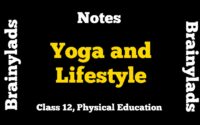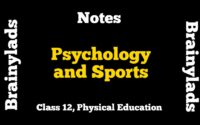Physical Education and Sports for CWSN | Questions Answers | Class 12 |
Physical Education and Sports for CWSN (Children with Special Needs – Divyang) Class 12 | Physical Education | Term 2 |
Physical Education : Physical Education and Sports for CWSN
Every individual wants to persist healthy life and achieve harmonious development. No one wants any hindrance in leading a daily fruitful life. There are people who cannot enjoy their life and are unable to meet their desires due to disability or disorder. Generally, these two terms disability and disorder are used interchangeably. It is necessary to understand the exact meaning and difference between these two terms. Nowadays sports for differently abled are also played by individuals with disability. Most of such sports for differently abled are modified in such a way that they meet the need of individual with certain disability. These are called organised sports for the sports person with a disability. Let’s have a look at some of the important questions of physical education and sports for CWSN (Children with Special Needs – Divyang).
Questions / Answers of Physical Education and Sports for CWSN
Question 1: What do you mean by Disability?
Answer: Disability simple refers to the inability to do work or the reduction of functional ability to lead daily fruitful life. It is an impairment that may be cognitive, developmental, intellectual, mental, physical, sensory or some combination of these. A person’s life activities is substantially affected and may be present from birth or occur during a person’s lifetime.
Question 2: Define the term ‘Disorder’.
Answer: It is usually correlated to mental disabilities. A blip in usual functioning of the body is defined as disorder. It is an ailment due to which health of an individual is disturbed and hinderance is created in an individual performance. Moreover, the efficiency is reduced.
Question 3: What are three types of disability?
Answer: Some individuals are disabled due to some events that occurred during the course of their lives whereas other individuals are disabled at the time of birth. There are the following three types of disability:
- Cognitive disability
- Intellectual disability
- Physical disability
Question 4: Define Cognitive disability.
Answer: The neurological disorder due to which hindrance or obstruction is created for an individual in order to store, process and produce information. An individual’s ability or capability to read, compute, speak and write is affected. Such a disability is also known as invisible disability since the condition of this disability can not be assessed by just looking at the individual.
Question 5: What are the symptoms of cognitive disability? explain in details.
Answer: The individuals who have the cognitive disability usually have the the following symptoms:
Memory Disorder: An individual having auditory problem or difficulty in remembering things that he or she has heard or said some time ago.
Hyperactivity: An individual having cognitive disability may not have attention for a long period of time or find difficult to stay at one place. Moreover, he / she loses concentration frequently.
Dyslexia: It refers that an individual finds difficulty in reading, writing and speaking.
Question 6: What do you mean by intellectual disability?
Answer: The disability that is characterized by significant limitations both in intellectual functioning as well as in adaptive behaviour is usually referred as intellectual disability. This type of disability is concerned with individual’s thought process, communication, money, learning, problem solving and judgement. Psychatric disability is also included in it which is related to individual social disability such as behaviour, emotion and thinking.
Question 7: Discuss about physical disability.
Answer: The limitation on an individual’s physical functioning, mobility, dexterity or stamina is usually referred as physical disability. It also include other impairments such as respiratory disorder, blindness, epilepsy and sleep disorder. It may either be mobility impairment or sensory impairment. Mobility impairment or motor deficiency is related to spinal cord causing paralysis to all the limbs whereas sensory impairment is related to individuals visual or hearing impairment.
Question 8: List the causes of disability.
Answer: There are various causes of disability that are written below:
- Genetic causes
- Poverty
- Dangerous working environment
- Mental health problem
- Medicine and vaccine
- Disturbance in endocrine gland
- Toxic materials such as pesticides and insecticides
- Poor approach to healthcare
- Accidents
- Malnutrition
Question 9: ” Malnutrition may cause disability”. Explain this statement.
Answer: Malnutrition is a significant cause of disability since if a child does not get appropriate nutrition he may be physically weak. Deficiency of calcium leads to malformation of bones where is deficiency of iodine diminish the growth of an individual. Similarly deficiency of vitamin A leads to blindness in children.
Question 10: What are the types of disorder?
Answer: There are following types of disorder:
- Attention deficit hyperactivity disorder (ADHD)
- Sensory processing disorder (SPD)
- Autism spectrum disorder (ASD)
- Oppositional defiant disorder (ODD)
- Obsessive compulsive disorder (OCD)
Question 11: Discuss about Attention Deficit Hyperactivity Disorder along with its symptoms.
Answer: The group of behavioral symptoms that include inattentiveness, hyperactivity and impulsiveness usually refers to attention deficit hyperactivity disorder. It often begins in childhood and can persist in adulthood. It can also lead to to low self-esteem, troubled relationships and difficulty at school or work.
There are various symptoms of ADHD that are listed below:
- Forget about daily activities
- Easily distracted
- Make careless mistakes
- Usually talk excessively
- Usually remain unorganised
- Indulge in daydreaming
- Problem in controlling anger
Question 12: What do you mean by sensory processing disorder? Discuss the causes of SPD.
Answer: The condition where in the brain has difficulty in receiving as well as in responding to the information that comes in through the sensors is referred to sensory processing disorder. It can be correlated with the way the nervous system receives messages from the sensors and then turns them into proper motor and behavioural responses. It is a sort of neurological traffic jam that prevent certain part of the brain from receiving information in order to interpret sensory information accurately.
Though accurate causes of SPD are yet unknown but some potential causes are listed below:
- Genetic Cause
- Low Birth Weight
- Physical Cause
- Environmental Factor
Question 13: Elucidate about Autism Spectrum Disorder.
Answer: The type of disorder that is characterised by social interaction difficulties, communication challenges and a tendency to engage in repetitive behaviours is termed as Autism spectrum disorder. Children with ASD may behave differently or repeat same activities over and over again like touching the same object. They also avoid eye contact and prefer to be alone. They repeat words and actions and do not like embraced. Moreover, they are very sensitive to taste, smell and sound.
Question14: Discuss the causes of Autism Spectrum Disorder (ASD) in detail.
Answer: ASD cannot be correlated with a single cause. This type of disorder results from different causes that are stated below:
- Genetic Factors: it is one of the significant cause of autism spectrum disorder. This problem can happen in two ways. One is either that something happens during fetal development that alerts a gene or the child inherits problematic gene from one or both parents.
- Environmental Factors: It has been found that mother exposed to higher level of pesticides and air pollution may also be at a higher risk of having a child with ASD.
- Brain Development: In children with this disorder the brain grows at a faster rate during the first three years of childhood. Such children have more number of cells than the requirement. Moreover the connection between the cells are not accurate.
Question 15: What do you mean by Oppositional Defiant Disorder (ODD) ?
Answer: It is a set or group of behavioural disorder that is also known as disruptive behaviour disorder. Children having ODD usually described to those around them. It can be considered as the pattern of disobedient, hostile and defiant behaviour aimed with authority. Individuals affected by this type of this order usually exhibit angry outbrusts and found difficult in controlling their aggression. They find it difficult to make friends and usually have low esteem. Moreover they have negativity in their behaviour. They try to blame others for their mistake and never comply with requests. They argue with others, behave like rebel and refuse to obey.
Question 16: What is Obsessive Compulsive Disorder (OCD) ?
Answer: When an individual gets caught in a cycle of obsession and compulsions when such a condition is usually referred as obsessive compulsive disorder. Individuals having OCD are afflicted by constant thought of fear that causes them to perform rituals or routine. Such disturbing thoughts are considered as obsessions and rituals are referred as compulsions. It is simply a mental disorder that cause repeated unwanted thoughts. In order to get rid from the unwanted thoughts individual perform an activity or task again and again. Example: A person may fear that everything he touches has germs on it and in order to get rid from that fear he washes hands again and again.
Question 17: Mention some obsession that a person having OCD have.
Answer: Some of the obsession are mentioned below:
- Fear of harm to yourself or a loved one
- Fear of being embarrassed
- Fear of getting dirty
- Fear of making mistakes
- Having excessive doubt on any individual
- Fear of contamination by germs
Question 18: Mention some compulsions that a person with OCD perform.
Answers: Some of the main compulsions are mentioned below:
- Repeating specific words
- Repeating things always moving things in order to keep them in an accurate order
- Praying constantly
- Checking things repeatedly
- Bathing or washing hands over and over again
- Hoarding
Question 19: What do you mean by disability etiquettes? Mention some general disability etiquettes.
Answer: The set of guidelines that deals specifically with how to approach persons with disability is usually referred as disability etiquettes. The general disability etiquettes are stated below:
- Avoid using the term disabled person and always put the person first and address as person with disability. Outdated words such as handicapped, retarded, physically challenged should be avoided.
- Always introduce yourself to a person who are blind using your name.
- Asking personal questions to individuals who are differently able should be avoided.
- Never leave a person who is blind without informing him.
- While talking with a person who is on a wheelchair or uses crutches, try to keep yourself at the eye level in front of that person in order to facilitate the talk.
- Avoid pretending to understand if you are facing problem in doing so.
Question 20: Discuss the various strategies to make physical activities accessible for children with special needs in details.
Answer: Following consideration should be taken into mind in order to make physical activities assessable for children with special needs:
- Medical Check Up: It is necessary to have the medical check up of all children with special need in order to know about the type of disability the child is facing.
- Physical activities must be based on the interest of children.
- Equipment related to physical activity should be as per the need of the children.
- Rules should be modified according to the need of the children with disabilities.
- A variety of different instructional strategies should be used.
- Children’s previous experience should be taken into consideration.
- Specific environment should be provided.
Related
|
|
Do share this post if you liked Physical Education and Sports for CWSN. For more updates, keep logging on BrainyLads.


